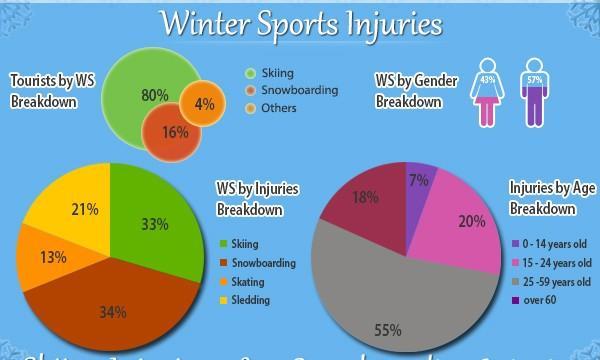Winter sports injuries are very common, with an average of 246,000 people treated at emergency rooms, hospitals, and doctors’ offices every year for injuries related to winter sports (U.S. CPSC). More than half of the injuries result from snow skiing and snowboarding.
This figure includes:
- 69,000 injuries from snow skiing
- 54,000 injuries from snowboarding
- 52,000 injuries from ice skating
- 5,000 injuries from sledding and tobogganing

Typical winter sports injuries include sprains, strains, dislocations, and fractures. Often these occur at the end of an action-packed day when we overexert ourselves to get in that last run. The most common skiing and snowboarding injuries are wrists, knee, back, shoulder, ankle sprains, and fractures. In fact, a fracture of the Talus bone, located above the heel bone on the outside of the ankle, is so common that it is known as “snowboarder’s ankle.”
How to Prevent Winter Sports Injuries
First, and importantly, make sure that you are ready to hit the slopes or ice. If you are not a regular exerciser, or if you are a “weekend warrior,” begin winter sports gradually and cautiously. Do lots of stretching and try foot, ankle and knee strengthening exercises to prepare for what can be strenuous activities.
Other ways to avoid winter sports injuries include:
- Take some lessons to learn the correct technique. Your instructor will also demonstrate how to fall properly which can help to prevent injury.
- Do a quick warm-up – jogging in place is a good idea – and stretch to minimize stress and strain on muscles and ligaments. Colder muscles are tighter and need more time to get ready to work out.
- Wear the right protective equipment. Invest in well-fitting, high–quality skates, boots, and shoes – this is not the time to save money by purchasing used equipment. Use a helmet that is specifically designed for your activity.
- Drink plenty of water before, during and after activities.
- Check your gear before each outing. Make sure laces and buckles are sturdy and unbroken.
- Take a partner with you. Even a minor injury can become life-threatening in frigid temperatures.
- Know your limits and stop when you begin to tire or are cold.
|
Please come to see us right away if you have injured your back, shoulder, elbow, wrist, knee, hip, foot or ankle. Quick and professional treatment is essential for long–term healing.